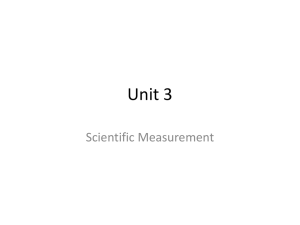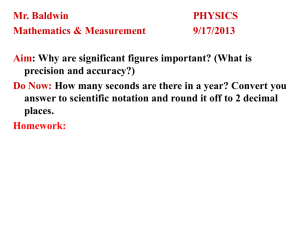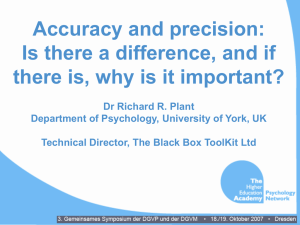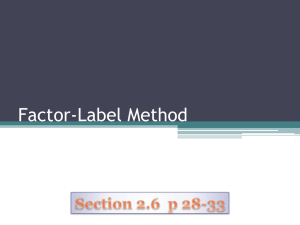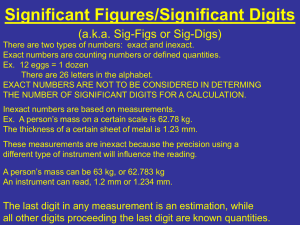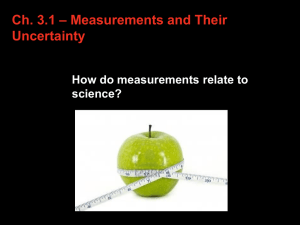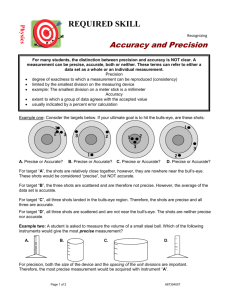Measurement Workshop: History, Precision, and Accuracy
advertisement
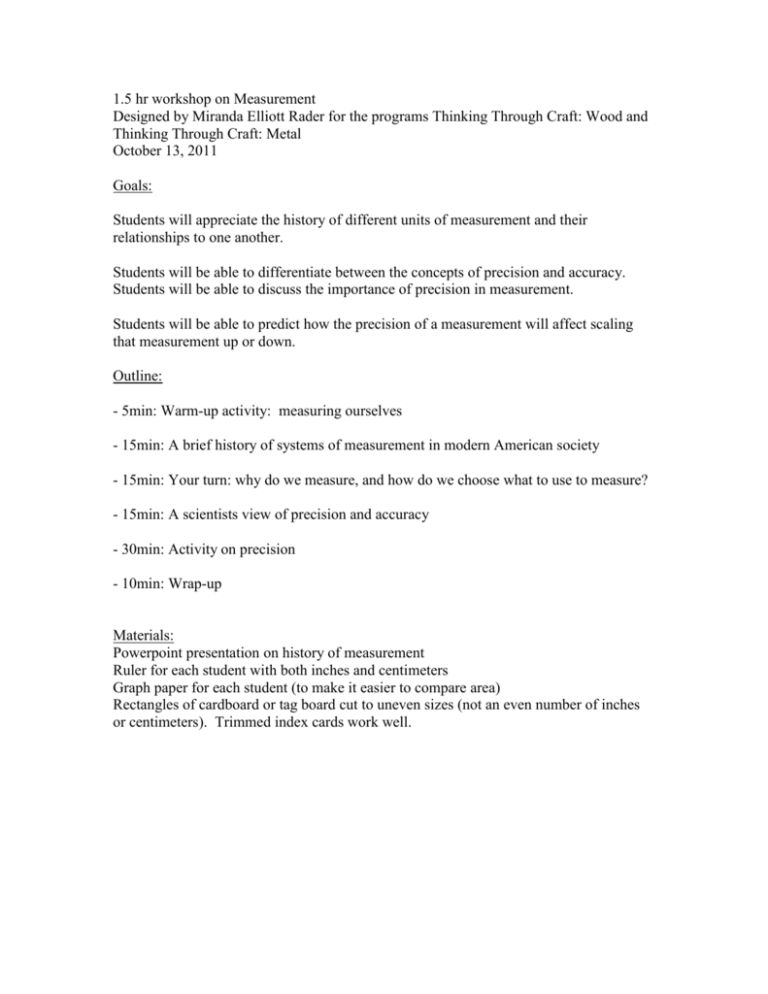
1.5 hr workshop on Measurement Designed by Miranda Elliott Rader for the programs Thinking Through Craft: Wood and Thinking Through Craft: Metal October 13, 2011 Goals: Students will appreciate the history of different units of measurement and their relationships to one another. Students will be able to differentiate between the concepts of precision and accuracy. Students will be able to discuss the importance of precision in measurement. Students will be able to predict how the precision of a measurement will affect scaling that measurement up or down. Outline: - 5min: Warm-up activity: measuring ourselves - 15min: A brief history of systems of measurement in modern American society - 15min: Your turn: why do we measure, and how do we choose what to use to measure? - 15min: A scientists view of precision and accuracy - 30min: Activity on precision - 10min: Wrap-up Materials: Powerpoint presentation on history of measurement Ruler for each student with both inches and centimeters Graph paper for each student (to make it easier to compare area) Rectangles of cardboard or tag board cut to uneven sizes (not an even number of inches or centimeters). Trimmed index cards work well. -Warm-up activity: Measuring ourselves. Stand up, shake it out. Write on board after saying: How many fingerwidths from your elbow to the tip of your finger? How many fingerwidths tall is your head? How many fingerwidths long is your hand? How many hands tall are you? Compare your findings with your neighbors. - History of systems of measurement in modern American society: brief powerpoint presentation: All over the world, many people use units of measurement based on the human body. In many circumstances, they’re the most practical and useful forms of measurement. Think of a tailor-made suit, or a chair or table that’s the right height for you. Ancient Romans used paces, the yup’ik of Alaska use the yagneq, the length from fingertip to fingertip, and subdivisions based on other parts of the body. The “cubit”, the distance that you measured between your elbow and the tip of your finger is a classic unit used historically all over northern Africa and the middle east. Story of the Smoot: Even in the modern era, body-based measurements can turn into commonly accepted, useful measurements. In 1958, an MIT fraternity used the height of one of their new members, Oliver Smoot, to measure the Harvard bridge (a bridge across the river between Boston and Cambridge) in Smoots – about 5’7”. The entire bridge was found to be 364.4 Smoots long The “smoot markings” are refreshed in paint every year. Eventually, they became commonly used – police used the smoot markings to locate crashes, and since no other measurement of the bridge has been undertaken, the cement company that made new sidewalk slabs made them in 5’7” slabs instead of the usual 6’. Interestingly, Oliver Smoot later became president of the International Standards Organization. Many large civilizations made standardized measurements for length and weight(mass) to facilitate trade and taxation (chinese empire, Japan, northern india, 16th century songhai empire in western africa). They made “systems of measurement” – specific, defined, agreed upon basic quantities – units – for things that needed to be measured: length, area, volume, weight/mass, time, angle, etc. The current systems of measurement that we use most in the US are the US Customary system, which is basically the same as the English or Imperial system (feet and miles, pounds and ounces, pints and gallons) and the metric or international standard system (SI units). However, there are many different particular units, or different definitions of units, that apply to only specific substances (hardware, board feet, cord of wood, women’s clothing sizes, and beyond) The English system is based on the measurements that evolved in English society, primarily by royal decree. These units began as body-measured units, whether the greek proportion-based body units or Roman units. As English units began to be standardized some were based on body part lengths of the king, etc. Edward the 1st (13th century England) standardized the yard, foot, and inch (the inch was later standardized as the length of three barleycorns laid end to end) and their proportions, and measures were further standardized and defined by successive monarchs. The pound is the base unit of weight in the English system and divided into 16 ounces. The metric system began in the late 1700’s in France just before the French revolution. France had previously had a completely non-standardized system of measures of which a main one was the “king’s foot”. The spirit of pro-rationality and pro-science among the elite, the intense need for a standardized measuring system, and the anti-king spirit of the revolution all combined to make France adopt the metric system. A council of French mathematicians and scientists decided to use 1/10,000,000 (one ten-millionth) of a quarter of the earth’s circumference as the meter; they surveyed a longitude line through France and used this to calculate. Unfortunately, the Earth is not actually perfectly spherical, so their measurement was inaccurate (we’ll talk more about what “accuracy” means exactly later). Nonetheless this measure was adopted as the meter. A standard meter-long metal bar was constructed in 1889, and since 1983 the meter has been defined as the distance that light travels in approximately 1/300,000,000th of a second (one 300 millionth). The kilogram is defined based on a prototype (a metal kilogram) in a vault in France. It was originally conceived as the mass of a cube of water whose sides are 10 centimeters long. A gram is one-one thousandth of a kilogram, or the mass of one cubic centimeter of water. Other useful facts about grams: a nickel weighs five grams and 1 ounce is about 28.35 grams. - Your turn: why do we measure, and how do we choose what to use to measure? Make a group of three with people sitting near you. For about 5 minutes, discuss these two questions: Why do we measure? How do we choose what to use to measure? (discussions happen). Let’s come back together. Who would like to share what their group came up with? Record ideas. Get out: To find a value or an amount. To be able to compare. To make things work. Allow things to interface with other objects from the same system of measurement. - A scientist’s view of precision and accuracy: I heard people mention precision, being exact. I’m going to give you some scientific definitions of the terms precision and accuracy. Scientists mean something very particular by precision. Write on board: Precision: How reproducible a measurement is – with high precision, you measure multiple times and get the same result. Also the degree of “granularity” or “detail” to a measurement, how “fine” the measurement is – what is the smallest subdivision that you can measure? Example: two scales at the co-op. Analog scale has markings every ¼ pound, and the pointer is fat: you can know the weight within ¼ of a pound. Digital scale has readouts to within one 1/100th of a pound: it is more precise. Accuracy: closeness of a measured value to the “real” or “actual” value. Example: the scale might read 2 and ¼ pounds but the scale is off by one pound, and really your fruit only weighs 1 and ¼ pounds: the measurement is inaccurate. Another example: one time the QuaSR Center made rulers. But they photocopied them, which inadvertently shrunk them slightly. So while the new rulers are just as precise (they also measure to within one-eighth of an inch) they are inaccurate because they report inches which aren’t inches. Measurements can be more and less precise, but no measurement is exact. Every measurement has some amount of inherent uncertainty. Even the definition of the meter is know only within 2 ten-millionths of a meter. Therefore, we have to be careful and observant as we measure in order to not introduce unnecessary uncertainties – warping, making big marks, etc – and lose some of the precision that our tool had. For scientists, the most important thing is to keep track of how precise your measurements are, and not report results that are more precise than the original measurements. Especially when you do calculations! - Activity on precision: Now we’ll get to try out measuring to different levels of precision, and see how it affects scaling. What happens to the precision of our measurements when we calculate with them? Get into groups of three again. Each person gets a piece of graph paper and a ruler, each group gets a rectangle of cardboard. Choose one person to be A, one to be B, and one to be C. Each person is going to measure the rectangle and then draw it scaled up by a factor of two (twice as large). But – each person is going to measure to a different level of precision. Person A measure to the closest inch (round to the nearest inch) before you scale the measurement. Person B round to the nearest half-inch before you scale. Person C measure to the nearest millimeter before you scale up. (if there are some groups of four, have someone measure to the nearest centimeter). Before you get started, have a little conversation so you are all on the same page – what does it mean to scale up by a factor of two? Is that the same as making the rectangle twice as large? When you’re done, compare your rectangles in your group. I’ll write up questions: How are your rectangles different? Are they different in proportion (the ratio of the sides)? Are they different in area? How? After your group has had time to discuss, find another group and compare your conclusions with their conclusions. Decide together: what happens to your error as you scale up? -Wrap-up. Report back on answers to questions above. What else did you see? What did you find out? What happened that you didn’t expect? It’s especially important to have different groups compare and try to generalize about their conclusions. One group may come up with an idea that is contradicted by another group!



